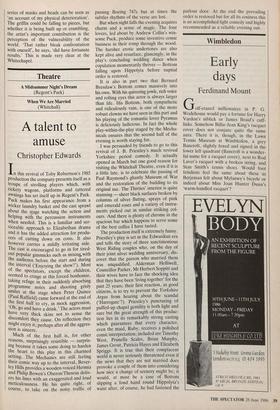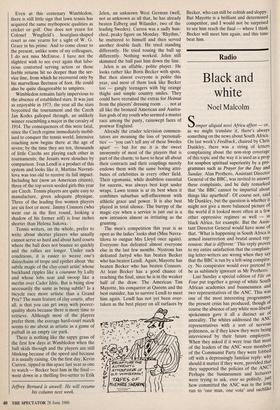Wimbledon
Early days
Ferdinand Mount
Even at this centenary Wimbledon, there is still little sign that lawn tennis has acquired the same mythopoeic qualities as cricket or golf. One does not yearn for Colonel Wingfield's hourglass-shaped court as one yearns for a sight of W. G. Grace in his prime. And to come closer to the present, unlike some of my colleagues, I do not miss McEnroe. I have not the slightest wish to see ever again that labo- rious contorted serving action or those feeble returns hit no deeper than the ser- vice line, from which he recovered only by his marvellous fleetness of foot. He could also be quite disagreeable to umpires.
Wimbledon remains fairly impervious to the absence of established stars. It was just as enjoyable in 1973, the year all the stars boycotted the tournament and the Czech Jan Kodes galloped through, an unlikely winner resembling a major in the cavalry of 1914. The consequences of this were fatal, since the Czech regime immediately mobil- ised to conquer the tennis world. Intensive coaching now begins there at the age of seven; by the time they are ten, thousands of little Czechs are playing each other in tournaments; the Jesuits were slouches by comparison. Ivan Lendl is a product of this system and looks like it, Martina Navrati- lova was too old to receive its full impact. Including her (now an American citizen), three of the top seven seeded girls this year are Czech. Tennis players are quite easy to manufacture, given adequate physique. Three of the leading five women players are six foot or more. Jimmy Connors (who went out in the first round, looking a shadow of his former self) is four inches shorter than Helena Sukova.
Tennis writers, on the whole, prefer to write about shorter players who usually cannot serve so hard and about hard courts where the ball does not bounce so quickly and the rallies are longer. Under such conditions, it is easier to weave one's daisychains of trope and epithet about `the subtle magic of the clay-court artist' whose backhand ripples like a courante by Lully and whose lobs soar and swoop like a merlin over Cader Idris. But is being slow necessarily the same as being subtle? Is a bicycle race more artistic than a Grand Prix? The main feature of clay courts, after all, is that you can get away with poorer- quality shots because there is more time to retrieve. Although most of the players prefer them, the average hard-court match seems to me about as artistic as a game of patball in an empty car park.
There is nothing like the sappy grass of the first few days at Wimbledon when the ball skids through and the players are still blinking because of the speed and because it is usually raining. On the first day, Kevin Curren, tipped in this space last year as one to watch — Becker beat him in the final went down in a thrilling five-setter to Erik Jelen, an unknown West German (well, not as unknown as all that, he has already beaten Edberg and Wilander, two of the leading Swedes). Curren was a sadly hun- ched, peaky figure on Monday. 'Rhythm,' he muttered to himself and then served another double fault. He tried standing differently. He tried tossing the ball up differently. Nothing worked. Jelen still skimmed the ball past him down the line.
Jelen is an affable, polite player. He looks rather like Boris Becker with spots. But then almost everyone is polite this year, and most of them look like Becker too — gangly teenagers with big orange thighs and simple country smiles. They could have recruited the extras for Heimat from the players' dressing room . . . not at all like the bronzed American and Austra- lian gods of my youth who seemed a master race among the pasty, rainswept faces of postwar England.
Already the cruder television commen- tators are moaning the loss of 'personali- ties' — 'you can't tell any of these Swedes apart' — but for me it is the sweet anonymity of most of the players that is part of the charm; to have to hear all about their contracts and their couplings merely endows them with the same boring attri butes of celebrities in every other field. Their egomania, while doubtless essential for success, was always best kept under wraps. Lawn tennis is at its best when it combines suburban self-effacement with athletic grace and power. It is also best played in total silence. The burrpp of the magic eye when a service is just out is a new intrusion almost as irritating as the grunting.
The men's competition this year is as open as the ladies' looks shut (Miss Navra- tilova to outgun Mrs Lloyd once again). Everyone has defeated almost everyone else in the last few months. Nystrom has defeated Jarryd who has beaten Becker who has beaten Lendl. Again, Mayotte has beaten Becker who has beaten Connors. At least Becker has a good chance of reaching the final, since he is in the weaker half of the draw. The American Tim Mayotte, his conqueror at Queens and the best outsider, has to survive Lendl to meet him again. Lendl has not yet been over- taken as the best player on all surfaces by Becker, who can still be coltish and sloppy. But Mayotte is a brilliant and determined competitor, and I would not be surprised to see him reach the final — where I think Becker will meet him again, and this time beat him.



















































 Previous page
Previous page